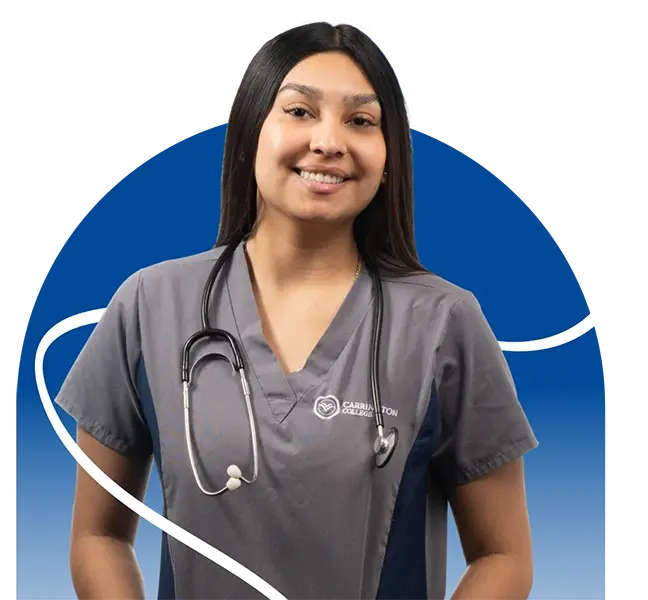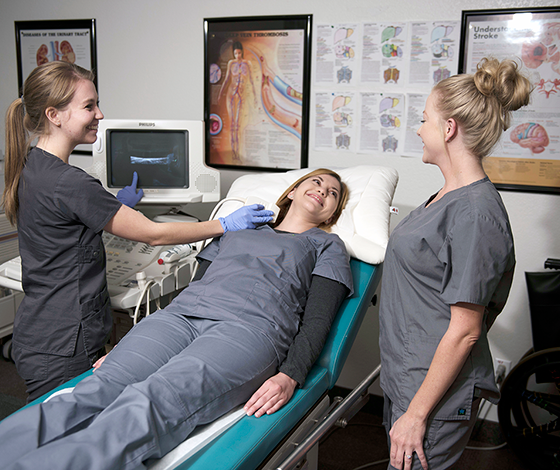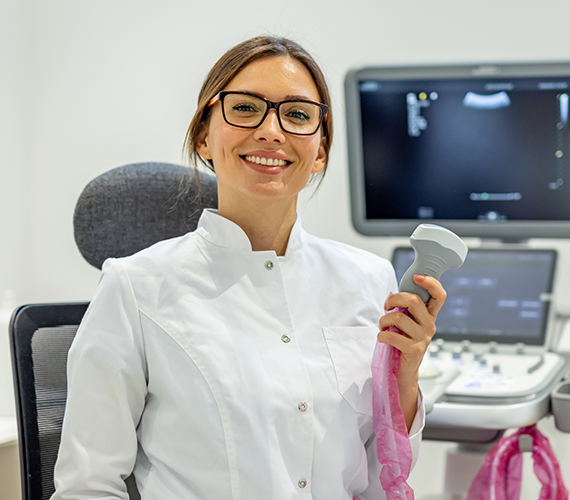Diagnostic Medical Sonography

Request Information
All fields using an asterik (*) are required.

Program Details
What Will I learn
Carrington College’s Diagnostic Medical Sonography program provides the technical skills and clinical experience needed to perform ultrasound imaging in a variety of medical settings. Upon completion of the Diagnostic Medical Sonography program, graduates will be able to:
- Evaluate normal anatomy and physiology using proper medical terminology.
- Exhibit appropriate patient care.
- Demonstrate the utilization of basic principles of ultrasound, image acquisition, and evaluation and selection of representative images.
- Perform abdomen, superficial structures, small parts, OB-GYN, and vascular ultrasound procedures and scanning techniques.
- Determine pathologies, congenital anomalies, lab values, and differential diagnoses.
- Relate and apply concepts of communication, reasoning, critical analysis, ethical behavior, and appropriate interpersonal interaction to situations in his or her career and personal life.
- Demonstrate the social skills, professional appearance, attitudes, and behavior that employers expect of graduates.
With a focus on real-world application, this program prepares students to work as entry-level diagnostic medical sonographers. Students will learn concepts of human anatomy, physiology, medical terminology, sonographic patient care, physical principles of ultrasonic waves, obstetrics, gynecology, vascular, abdominal, superficial, and small parts, as well as application of these hands-on skills.
Military Policy
Cost & Financial Aid
Your education is an investment in your future, and Carrington College is here to help. We offer a variety of financial aid options, including federal, state, and private programs, as well as student loans, grants, and scholarships are available for those who qualify. Each program has different requirements and application instructions. Our team is here to guide you through the options and application process.
Academic Cost
For complete details on current tuition costs, please refer to the Academic Catalog.
Location Availability
Carrington College is proud to offer our Diagnostic Medical Sonography program at multiple locations around the Western U.S. To learn more about our locations, explore their pages.
Accreditation & Approvals
Carrington College is accredited by the Accrediting Commission for Community and Junior Colleges, 428 J Street, Suite 400, Sacramento, CA 95814; 415 506 0234 an institutional accrediting body recognized by the Council for Higher Education Accreditation and the U.S. Department of Education. Additional information about accreditation, including the filing of complaints against member institutions, can be found at accjc.org.
For comprehensive information on Carrington College’s accreditation and approvals, visit carrington.edu/accreditation-and-approvals/.
Course Catalog
Program Specific Disclosures
Continuing Education For Graduates
Student Outcomes
Upon completion of the Diagnostic Medical Sonography program, graduates will be able to:
- Evaluate normal anatomy and physiology using proper medical terminology.
- Exhibit appropriate patient care.
- Demonstrate the utilization of basic principles of ultrasound, image acquisition, and evaluation and selection of representative images.
- Perform abdomen, superficial structures, small parts, OB-GYN, and vascular ultrasound procedures and scanning techniques.
- Determine pathologies, congenital anomalies, lab values, and differential diagnoses.
- Relate and apply concepts of communication, reasoning, critical analysis, ethical behavior, and appropriate interpersonal interaction to situations in his or her career and personal life.
- Demonstrate the social skills, professional appearance, attitudes, and behavior that employers expect of graduates.
REAL WORLD SKILLS
START YOUR PATH
LEARNING OPTIONS
AFFORDABLE TUITION

Career Opportunities
Diagnostic Medical Sonographers, also known as Ultrasound Technologists or Technicians, help doctors and other health care professionals assess and identify a patient’s medical conditions. These professionals use imaging equipment that produces high-frequency waves to record images or conduct tests on many parts of the body.
To understand a Diagnostic Medical Sonographer’s daily responsibilities, it is essential you know the difference between an ultrasound and a sonogram. While most use the terms interchangeably when discussing sonography, they are different. Ultrasound refers to the tool used to take a sonogram (or picture). According to the Bureau of Labor Statistics, diagnostic medical sonographers typically do the following: Here is an overview of the daily duties of an ultrasound tech:1
- Explain ultrasound diagnostic imaging to patients and record their medical history
- Follow approved procedures to ensure that diagnostic equipment is working properly
- Operate equipment under authorized diagnostic image practices and approaches
- Review images for clarity, coverage, and suitability to detect the presence or absence of a presumed medical condition
- Distinguish between normal and abnormal anatomy to prepare a summary of your diagnostic findings for the attending physician.
- Record findings and file patients’ records per prescribed procedures
- Sonography professionals may work with doctors and surgeons before, during, and after these day-to-day procedures
What Will I Learn?
Introduction to Sonography and Patient Care
Ultrasound Physics and Instrumentation
Abdominal, Superficial, and Other Ultrasound Imaging
Gynecology and Obstetrics Ultrasound Imaging
Diagnostic Medical Sonography FAQ
-
Sonography (ultrasound) is a non-invasive diagnostic medical imaging procedure that is used to visualize organs or systems in the body. It is commonly used to monitor fetal growth and understand the health of the heart, the abdomen, and the vascular and musculoskeletal systems.
-
In the healthcare world, DMS stands for Diagnostic Medical Sonography, also known as ultrasound or ultrasonography. It is a medical imaging technique that uses high-frequency sound waves to generate pictures of structures within a human body, including bones, vascular system and organs. At Carrington College, our Associate of Science in Diagnostic Medical Sonography is designed to help you gain the skills to pursue career opportunities in the field. The program can be completed in as few as 18 months.
-
The key to becoming a diagnostic professional is education. Explore your ultrasound tech educational options. Make sure the college is accredited and offers the program that fits your future. Carrington College offers an Associate of Science in Diagnostic Medical Sonography program that covers the ins and outs of sonography in as little as 18 months. From there, you might consider pursuing a professional certification through the American Registry for Diagnostic Medical Sonography (ARDMS). Next, explore your employment options.